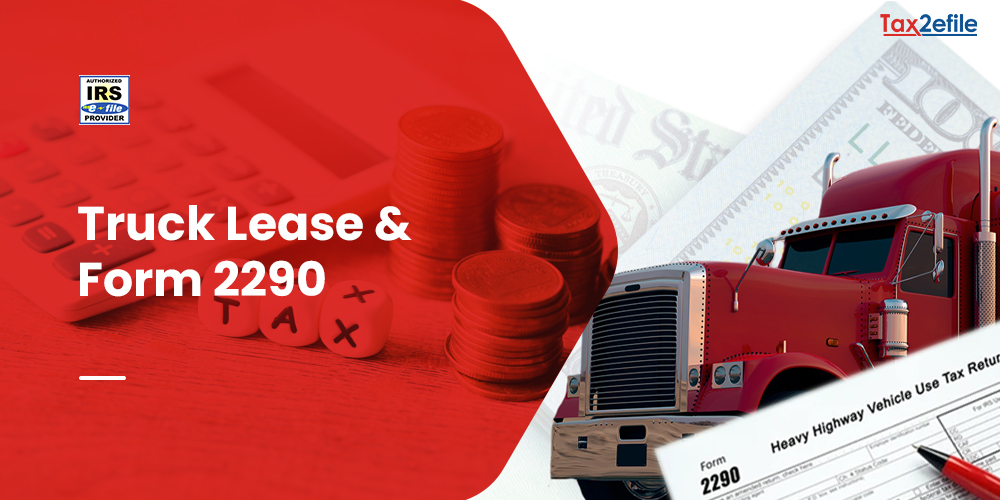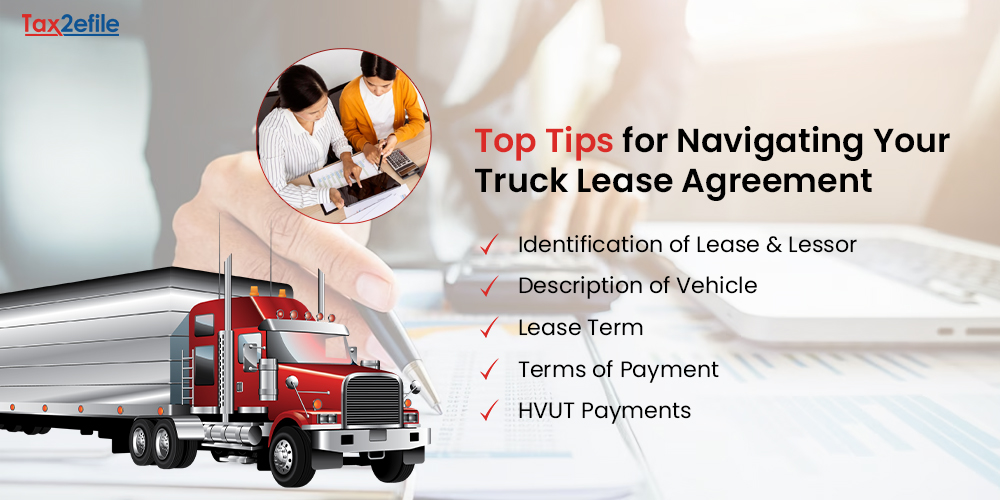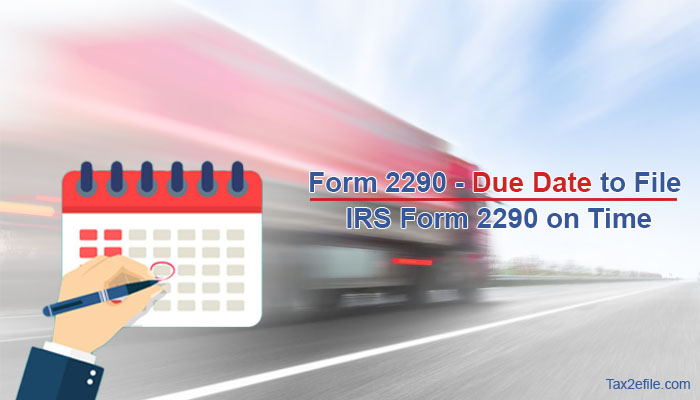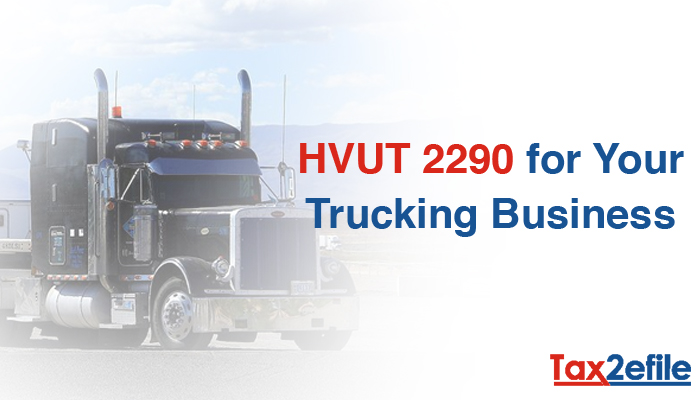- July 17, 2024

A truck lease or leasing is a financial agreement under which businesses and individuals use the trucks of some other owner for a specified period in exchange for lease payments. Those who operate a trucking business or drive a truck would be very familiar with IRS Form 2290. This tax Form is used to report and pay the heavy vehicle use tax. However, for those who are leasing a truck for their business, there are certain considerations to remember before filing this tax Form with the IRS. As a general rule, when a trucker leases a qualifying heavy vehicle, the lessee is responsible for paying the HVUT taxes.
Table of Contents
Who is Responsible for Filing Form 2290 for Leased Truck
The responsibility of filing Form 2290, which records and pays the Heavy Highway Vehicle Use Tax (HVUT), is determined by the lease agreement between the lessee (the individual or company leasing the truck) and the lessor (the vehicle owner). In most circumstances, the lessee, who owns and uses the vehicle, is responsible for completing Form 2290 and paying the HVUT. This is because the lessee is the party using the public highways and, hence, accountable for the tax. In some leasing arrangements, the lessor (truck owner) may be responsible for filling out Form 2290 and paying the HVUT. This generally depends on the duration of the truck lease, and its governing conditions are as follows.
If the trucker leases the vehicle for less than 30 days, the lessee is exempt from paying the HVUT taxes. In such cases, the lessor takes on the responsibility of reporting and paying the HVUT taxes through Form 2290.
For long-term leases spanning 30 days or more, the lessee is responsible for paying the HVUT taxes. However, the lessor still has a role to play. They are responsible for reporting it on Form 2290, clearly indicating that it is reported for a leased vehicle. The lessor is also required to provide a copy of Form 2290 Schedule 1 to the lessee.
Furthermore, if the vehicle is leased for the entire tax period (July 1st through June 30th of the following year), the lessee is required to record and pay the HVUT for that time period. However, if the vehicle is leased for only a portion of the tax period, the lessee is required to prorate the tax based on the number of months used.
To compute the prorated tax, the lessee must divide the number of months the vehicle will be utilized during the tax term by 12 (the total number of months in the tax period) and multiply by the total tax amount. For instance, if the truck is leased for four months of the tax year, then the prorated tax would be calculated as 4/12 x full tax amount, which is equivalent to the prorated tax amount.
Reviewing Your Truck Lease Agreement
The truck lease agreement is a legal document between the owner of the truck and the third party that is leasing the truck. This is an important document that outlines the terms and conditions under which the lessee uses the truck of the lessor for a specified period of time in exchange for payments. While drafting the truck lease agreement, it is important to review it carefully and understand the terms in the agreement.
It is mandatory to pay close attention to the vehicle wear and tear policies, the mileage limits of the truck, and penalties for early termination of the lease agreement. The following are the components of the lease agreement that have to be reviewed promptly. While reviewing the truck lease document, it is mandatory to pay attention to the following aspects.

- Identification of the Lessee and the Lessor: The truck lease agreement should state clearly who the owner of the truck is and who the leasing party is.
- Description of the Vehicle: The agreement should include a detailed description of the leased vehicle, including its model, year, and VIN.
- Lease term: The term of the lease should be clearly stated in the lease document with the start and end dates of the lease term. It should also clearly clarify if it is a short-term or long-term lease.
- Terms of payment: The lease document should detail the payment schedule, due dates, and additional charges and fees.
- Form 2290 filing and HVUT payments: The lease agreement should clearly state who is responsible for filing the form and paying the taxes, along with proof of payment.
- Miscellaneous: The other details that should be in the truck lease agreement on information on the maintenance and repairs of the truck, insurance requirements, use of the vehicle terms, information on taxes and fees, etc.
Filing and Payment Deadlines
Form 2290 is the federal form for filing Heavy Highway Vehicle Use Tax Returns. It records the annual highway use tax that must be paid by trickers who run heavy trucks on public roadways. The due date for filing Form 2290 varies from year to year, so it’s critical to know when the filing period begins and when the filing deadline is. The deadline for the submission of Form 2290 with the IRS is the same for leased trucks as well.
Form 2290’s filing period normally begins in July and ends on August 31. This means that truckers have until August 31st of each year to file and pay their taxes. If they fail to file on or before this date, they may face late filing fines and penalties.
If the truckers are unable to meet the filing date due to circumstances beyond their control, they may request an extension of time to file Form 2290. This extension allows them to file Form 2290 late without incurring any fines or penalties. However, the extension does not provide grace time for paying the taxes; it is only for submitting Form 2290. The taxes must still be paid on or before the original due date to avoid any penalty or fines.
This extension of time must be requested before the original due date of 31 August of the tax year. Taxpayers must plan ahead and ensure that their tax filing is complete on or before the due date. The penalty for late filing of Form 2290 will be equal to half the amount of the tax due or at least $50, along with other late payment penalties.
Proof of Payments and Record-Keeping
It is beneficial for both the lessee and the lessor to maintain proof of payments and other proper records for the IRS Form 2290. This is a crucial tool that helps to maintain compliance with the IRS regulations and to enhance operational efficiency. The following proof of payments should be kept safe for future references and audits.
- A stamped copy of Schedule 1: After the 2290 Form is filled and the taxes are paid, the IRS will return a stamped copy of Schedule 1 that serves as proof of payment. This stamped copy should be retained safely as it will be required for the registration and renewal of the vehicle.
- Electronic filing confirmation: The Internal Revenue Service (IRS) advises taxpayers to E-file their tax returns as it avoids paperwork and is also very convenient. If the lessee or the lessor files Form 2290 electronically, they will receive an electronic acknowledgment from the IRS. This serves as an instantaneous proof of payment until stamped Schedule 1 is received. It is beneficial to save this electronic confirmation form in digital formats and as a hard copy.
The IRS also recommends its taxpayers keep records of payment of taxes for at least three years after the tax is paid. It is beneficial to retain copies of Form 2290, stamped copy of Schedule 1, tax filing extension form if applicable, e-filing receipt, and all other correspondence with respect to Form 2290 with the IRS.
Apart from these documents, it is also important to keep records with respect to vehicle safety. This includes the vehicle details, VIN, mileage reports, gross weight details, etc. The lessee and the lessor should also keep copies of these agreements safe as they outline their responsibilities for paying the HVUT taxes.
Consequences & Non-Compliances of Truck Lease Document
It is pertinent for both the lessee and lessor to keep the truck lease document, Form 2290, and tax payment confirmation documents safe. It is also mandatory for the lessor and the lessee to abide by the terms outlined in the truck lease agreement. There are federal and state laws that govern truck lease agreements, such as the Federal Motor Carrier Safety restrictions and state-specific trucking restrictions.
Before terminating a lease early, a trucker should thoroughly analyze the terms of the agreement and weigh the potential implications. Some lease agreements allow for early termination, whilst others impose fees or obligations on the trucker. If a carrier violates the lease agreement, the trucker should document the violation, analyze the agreement for dispute resolution options, and take legal action. It is critical to act quickly and assertively to preserve one’s rights and interests in such situations.
Before signing a leasing agreement, a trucker should thoroughly understand the terms and negotiate them with the carrier. It is best to seek legal advice to ensure that the agreement is fair and beneficial, taking into account elements such as payment structure, maintenance requirements, and insurance arrangements. Any breach in the truck lease agreement should be dealt with legal recourse.


